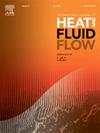Experimental Investigation on void structure velocity and estimation of velocity jump boundaries in a 3X3 rod bundle at low gas flow conditions
IF 2.6
3区 工程技术
Q2 ENGINEERING, MECHANICAL
International Journal of Heat and Fluid Flow
Pub Date : 2024-12-01
DOI:10.1016/j.ijheatfluidflow.2024.109653
引用次数: 0
Abstract
Air-water two-phase flow tests were performed in a 3X3 rod bundle channel under low gas-flow conditions. Gas and liquid superficial velocities of < jg> = 0.035–1.0 m/s and < jf> = 0.6–1.7 m/s were tested, which may cover the flow regimes of bubbly to cap-bubbly or slug/churn flows, and global and local void fractions were measured via non-intrusive conductivity void meters at different axial locations. The transient void signals were analyzed with cross-correlation technique to obtain the void structure velocities at various local/global regions, and these velocities were compared with one-dimensional (1D) drift-flux model. Under relatively low gas flow conditions, the void structure velocities were clearly lower than the average gas velocity estimated by 1D drift-flux model. While increasing gas flow rate, the void structure velocities at different regions can jump up and become comparable to the average gas velocities calculated by the 1D drift-flux model (DFM). These velocity jump conditions could be roughly explained by the changes of bubble sizes/shapes and distributions, and the transition boundaries of velocity jumps can be successfully estimated by introducing energy balance between fluid turbulent kinetic energy and bubble surface free energy of various sizes.
求助全文
约1分钟内获得全文
求助全文
来源期刊

International Journal of Heat and Fluid Flow
工程技术-工程:机械
CiteScore
5.00
自引率
7.70%
发文量
131
审稿时长
33 days
期刊介绍:
The International Journal of Heat and Fluid Flow welcomes high-quality original contributions on experimental, computational, and physical aspects of convective heat transfer and fluid dynamics relevant to engineering or the environment, including multiphase and microscale flows.
Papers reporting the application of these disciplines to design and development, with emphasis on new technological fields, are also welcomed. Some of these new fields include microscale electronic and mechanical systems; medical and biological systems; and thermal and flow control in both the internal and external environment.
 求助内容:
求助内容: 应助结果提醒方式:
应助结果提醒方式:


